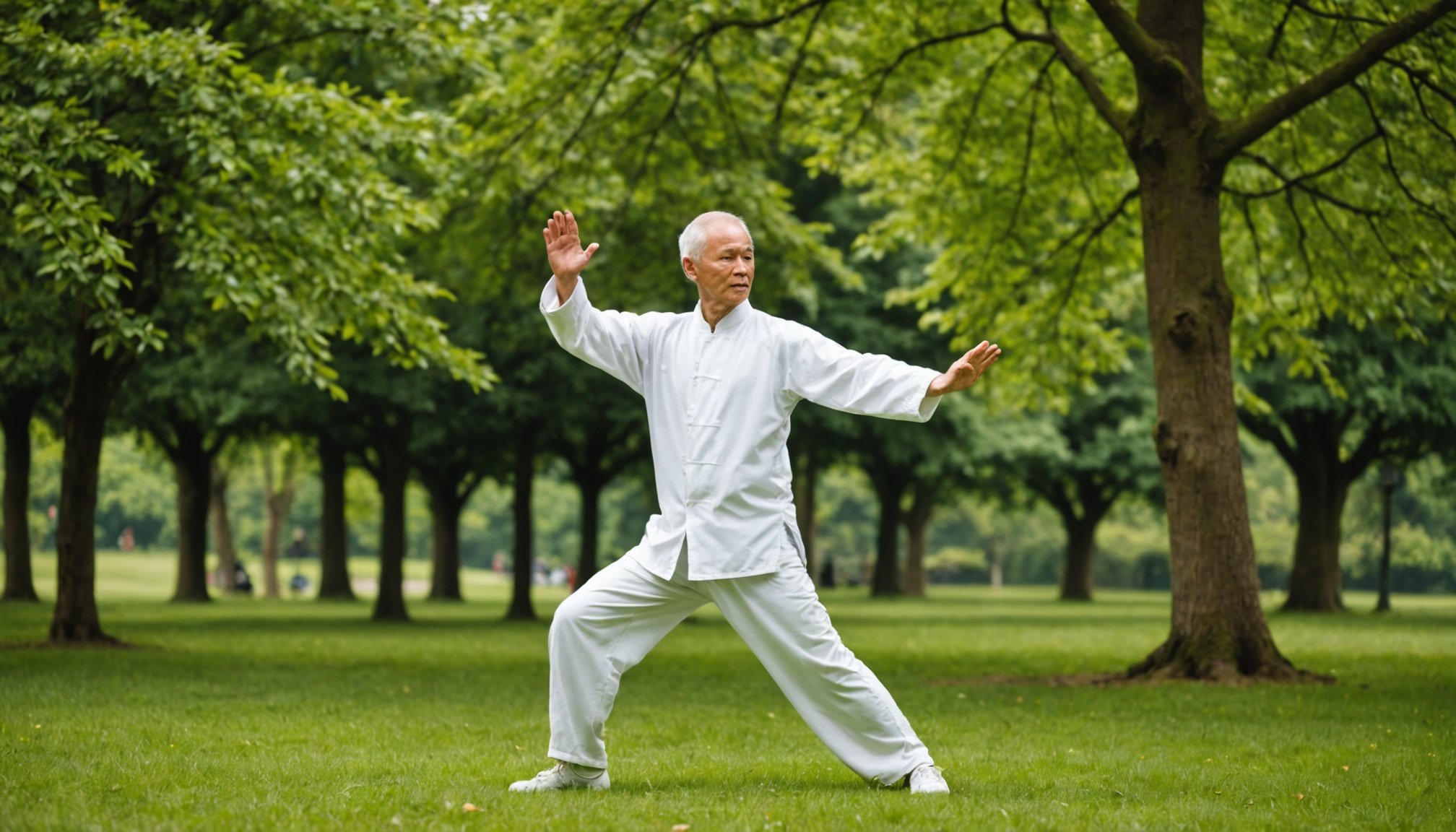Uncovering the Remarkable Benefits of Tai Chi for Easing Arthritis Symptoms in the UK Population to Tai Chi and Arthritis
Tai Chi, an ancient Chinese martial art, has evolved into a popular form of exercise that combines slow, flowing movements with deep breathing and meditation. For people in the UK living with arthritis, Tai Chi has emerged as a valuable tool in managing symptoms and improving overall health. This article delves into the benefits of Tai Chi for arthritis, exploring its effects on various types of arthritis, the scientific evidence supporting its use, and practical advice for incorporating Tai Chi into your health regimen.
Understanding Arthritis
Arthritis is a broad term that encompasses over 100 different conditions, but the most common types relevant to this discussion are osteoarthritis (OA), rheumatoid arthritis (RA), and psoriatic arthritis.
Also to read : Elevate your omega-3 consumption: easy strategies to enrich the uk diet
Osteoarthritis (OA)
OA is the most common form of arthritis, characterized by the wear and tear of joint cartilage. It often affects the hands, knees, hips, and spine, leading to pain, stiffness, and reduced mobility[4].
Rheumatoid Arthritis (RA)
RA is an autoimmune disease where the body’s immune system attacks the lining of the joints, causing inflammation, pain, and potentially severe joint damage. It can also affect other parts of the body, such as the skin, eyes, and internal organs[2].
Psoriatic Arthritis
Psoriatic arthritis is a type of arthritis that occurs in some people with psoriasis, a condition that causes red, scaly patches on the skin. It can cause pain, stiffness, and swelling in the joints, as well as other symptoms like fatigue and eye problems.
The Benefits of Tai Chi for Arthritis
Tai Chi offers a multitude of benefits for individuals with arthritis, making it an attractive addition to traditional treatment plans.
Improved Balance and Mobility
One of the most significant advantages of Tai Chi is its ability to improve balance and mobility. Studies have shown that Tai Chi can reduce the risk of falls among older adults, which is particularly beneficial for those with arthritis who may have compromised joint stability and mobility[1].
Reduced Pain and Inflammation
Tai Chi has been found to reduce pain and inflammation in people with arthritis. A systematic review and meta-analysis revealed that Tai Chi can decrease the rate of falls and the number of people falling at least once, with a significant reduction in pain and improvement in physical function[1].
Enhanced Muscle Strength and Flexibility
Tai Chi incorporates gentle stretching and strengthening exercises that can help improve muscle strength and flexibility. This is crucial for arthritis patients, as it helps maintain joint mobility and reduces the risk of further joint damage[3].
Psychological Benefits
Beyond the physical benefits, Tai Chi also offers psychological advantages. It includes deep breathing and mindfulness techniques that can help reduce stress, anxiety, and depression, all of which are common comorbidities with arthritis[3].
Scientific Evidence Supporting Tai Chi
The efficacy of Tai Chi in managing arthritis symptoms is backed by robust scientific evidence.
Systematic Reviews and Meta-Analyses
A systematic review and meta-analysis published in the Journal of Aging and Physical Activity found that Tai Chi significantly reduces the rate of falls and the number of people falling at least once among older adults. This review included multiple trials and demonstrated high-certainty evidence supporting the benefits of Tai Chi[1].
Randomized Controlled Trials
Randomized controlled trials have also shown promising results. A trial comparing Tai Chi with multimodal exercise and stretching control arms found that Tai Chi had a greater effect size in reducing falls and serious injurious falls among older adults at high risk of falling[1].
Practical Advice for Incorporating Tai Chi into Your Health Regimen
If you’re considering adding Tai Chi to your health program, here are some practical tips to get you started:
Finding a Qualified Instructor
Look for instructors who are certified in Tai Chi, especially those with experience in teaching people with arthritis. Organizations like “Tai Chi for Better Health” in the UK offer accredited courses and workshops[3].
Starting Slowly
Begin with gentle and slow movements. Tai Chi is not about speed or intensity but about fluidity and control. Start with short sessions and gradually increase the duration as you become more comfortable.
Adapting to Your Needs
Tai Chi can be adapted to suit different levels of mobility. For example, the Shibashi Set 1 exercises can be done while seated, making it accessible for those with restricted mobility[3].
Comparison of Tai Chi with Other Exercise Programs
Here is a comparison of Tai Chi with other common exercise programs for arthritis management:
| Exercise Program | Benefits | Suitability for Arthritis | Intensity Level |
|---|---|---|---|
| Tai Chi | Improves balance, reduces falls, enhances muscle strength and flexibility, reduces pain and inflammation, psychological benefits | Highly suitable for OA, RA, and psoriatic arthritis | Low to moderate |
| Multimodal Exercise | Improves physical function, reduces falls, but less effective than Tai Chi in some studies | Suitable for OA and RA | Moderate to high |
| Hydrotherapy | Reduces joint pain, improves physical function, especially beneficial for weight-bearing joints | Highly suitable for OA and RA | Low to moderate |
| Strength Training | Improves muscle strength, stabilizes joints, but must avoid over-training | Suitable for OA and RA | Moderate to high |
| Yoga | Improves flexibility, balance, and strength, but may not be as effective as Tai Chi in reducing falls | Suitable for OA and RA | Low to moderate |
Real-Life Examples and Testimonials
Many people in the UK have found significant relief from arthritis symptoms through Tai Chi.
Case Study: Jane’s Journey
Jane, a 65-year-old woman from London, was diagnosed with osteoarthritis in her knees. After trying various treatments, she discovered Tai Chi through a local community center. “Tai Chi has been a game-changer for me,” Jane says. “It has improved my balance, reduced my pain, and given me a sense of calm I never thought possible.”
Testimonial from a Scholar
Dr. Jason Liebowitz, a rheumatologist, emphasizes the importance of physical therapy, including exercises like Tai Chi, for managing rheumatoid arthritis. “Exercise in RA is likely most helpful in reducing functional limitations and maintaining good overall health,” he notes. “Tai Chi, with its focus on balance, strength, and mindfulness, is an excellent choice for many patients”[2].
Dietary and Lifestyle Changes to Support Arthritis Management
While Tai Chi is a powerful tool, it is part of a broader approach to managing arthritis. Here are some dietary and lifestyle changes that can complement your Tai Chi practice:
Mediterranean Diet
The Mediterranean diet, rich in whole foods like oily fish, fruits, vegetables, beans, legumes, whole grains, nuts, and seeds, has been shown to reduce inflammation and improve symptoms of osteoarthritis[4].
Avoiding High-Impact Activities
For people with osteoarthritis, avoiding high-impact activities such as running on hard surfaces can help reduce joint stress and prevent further damage[4].
Incorporating Other Therapies
Other therapies like heat therapy, massage, and hydrotherapy can also be beneficial. Heat therapy, for example, can relax joints and muscles, while hydrotherapy can reduce joint pain and improve physical function without adding unnecessary stress on the joints[2].
Tai Chi is a multifaceted exercise program that offers a range of benefits for individuals with arthritis in the UK. From improving balance and mobility to reducing pain and inflammation, Tai Chi is a valuable addition to any arthritis management plan. With its low to moderate intensity level and adaptability to different mobility levels, Tai Chi is accessible to a wide range of people. By combining Tai Chi with dietary and lifestyle changes, individuals can significantly improve their quality of life and manage their arthritis symptoms more effectively.
In conclusion, if you’re living with arthritis in the UK, considering Tai Chi as part of your health regimen could be a wise decision. With its proven benefits, gentle approach, and holistic focus, Tai Chi can help you navigate the challenges of arthritis with greater ease and improved health. So why not give it a try? Your body—and mind—will thank you.

